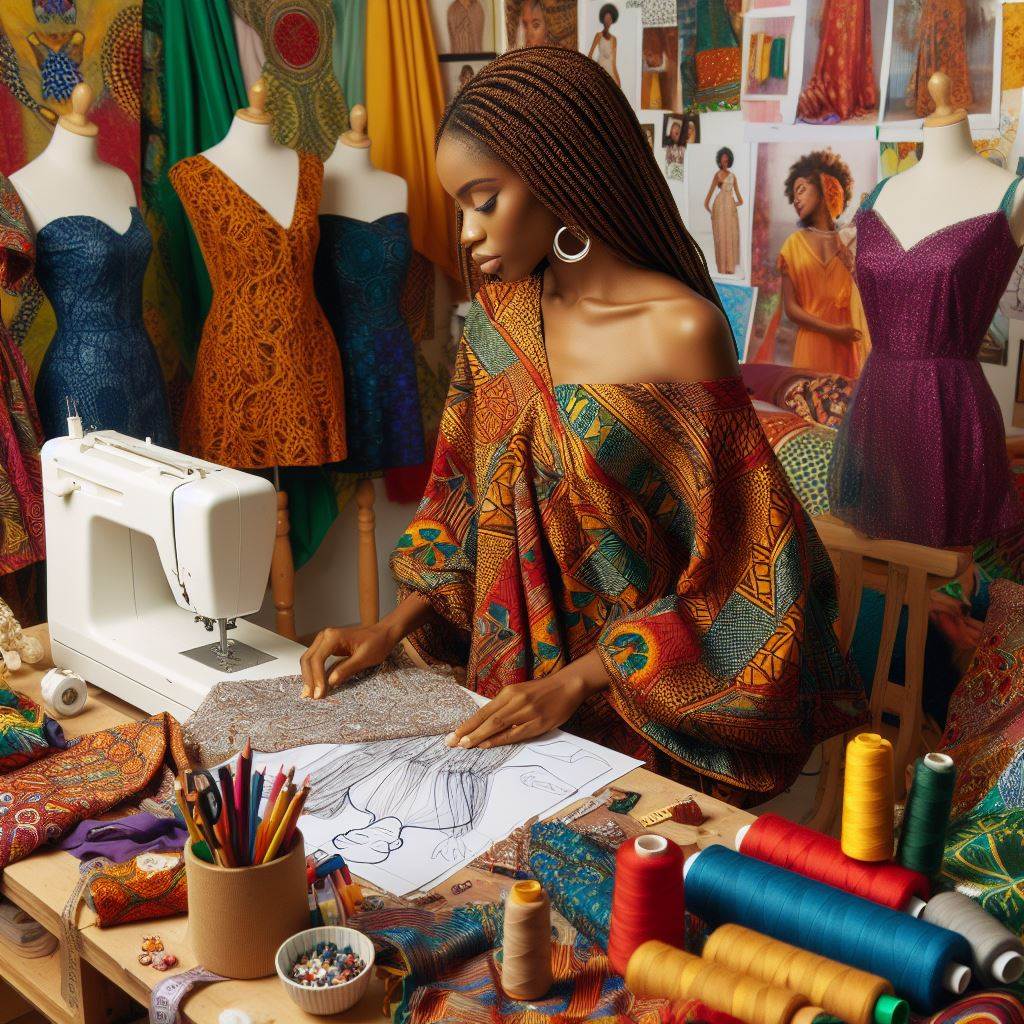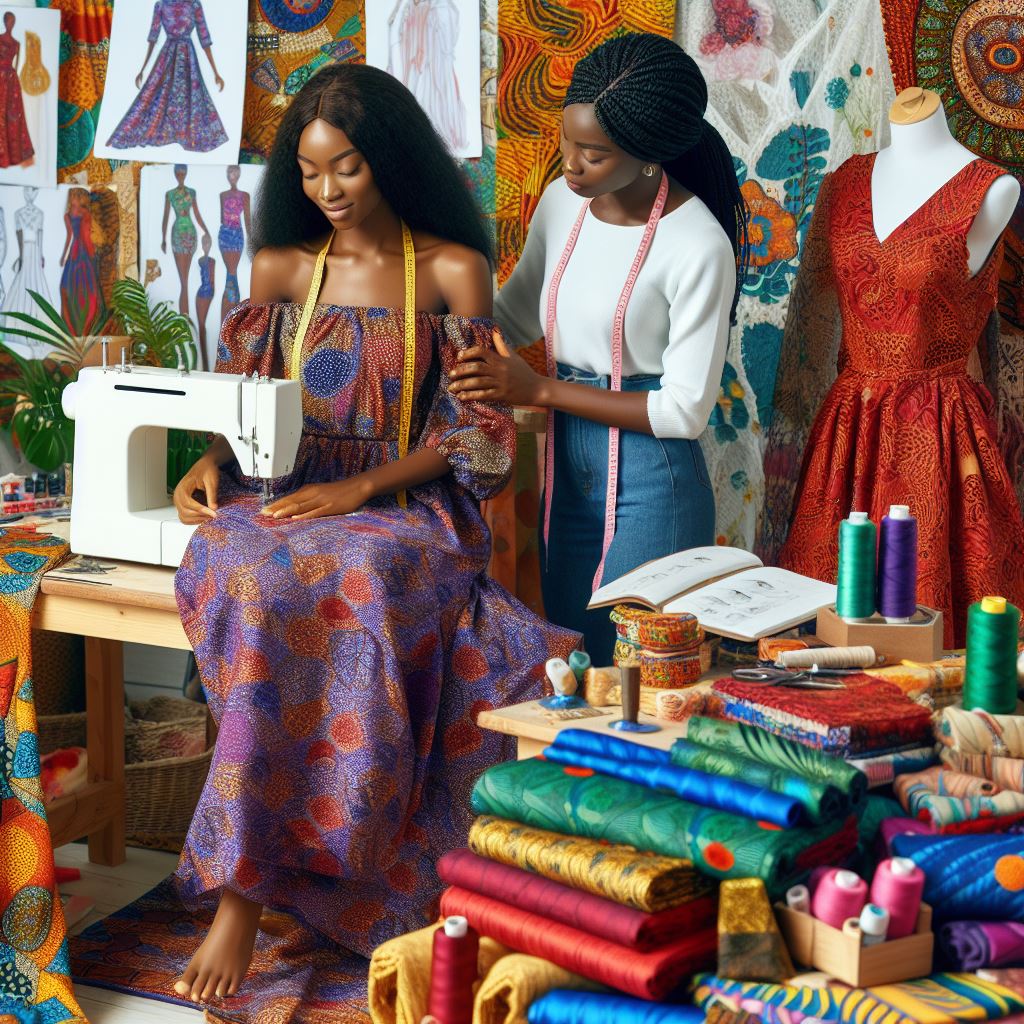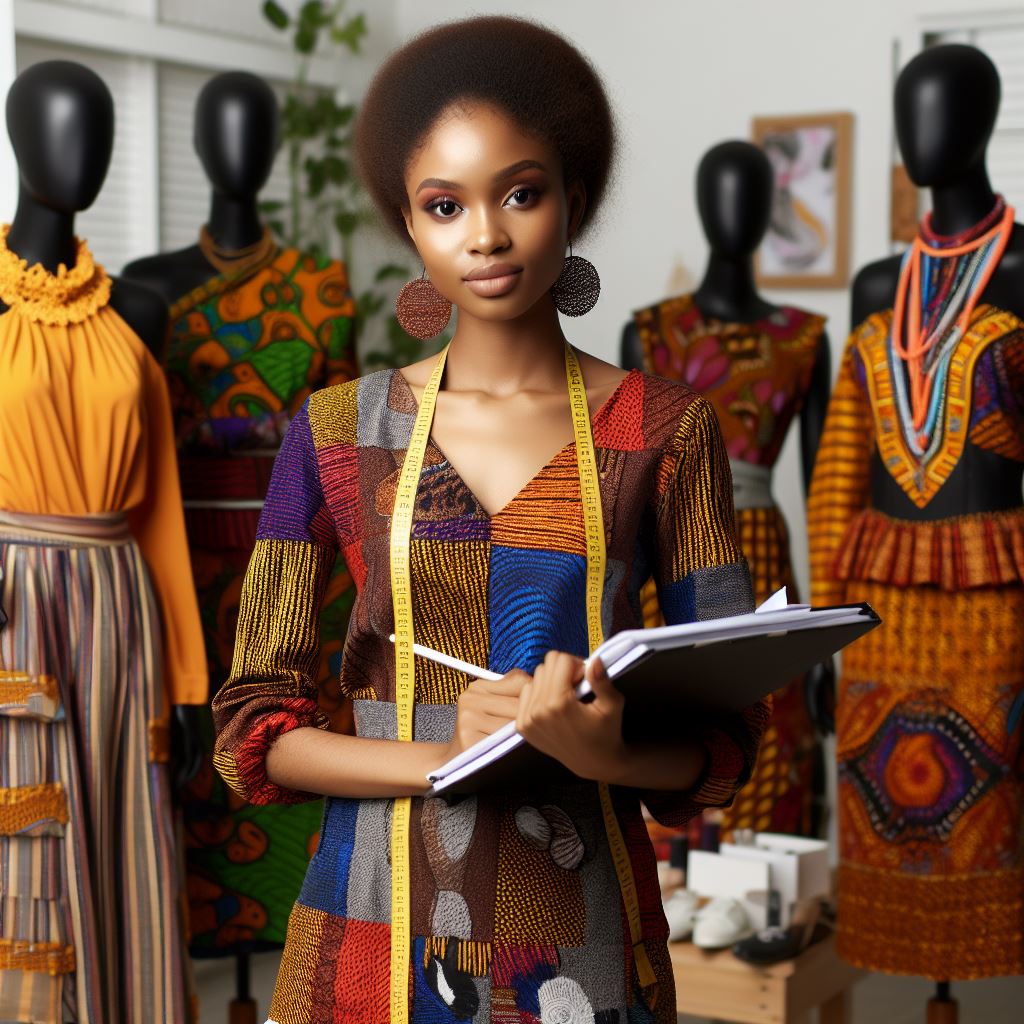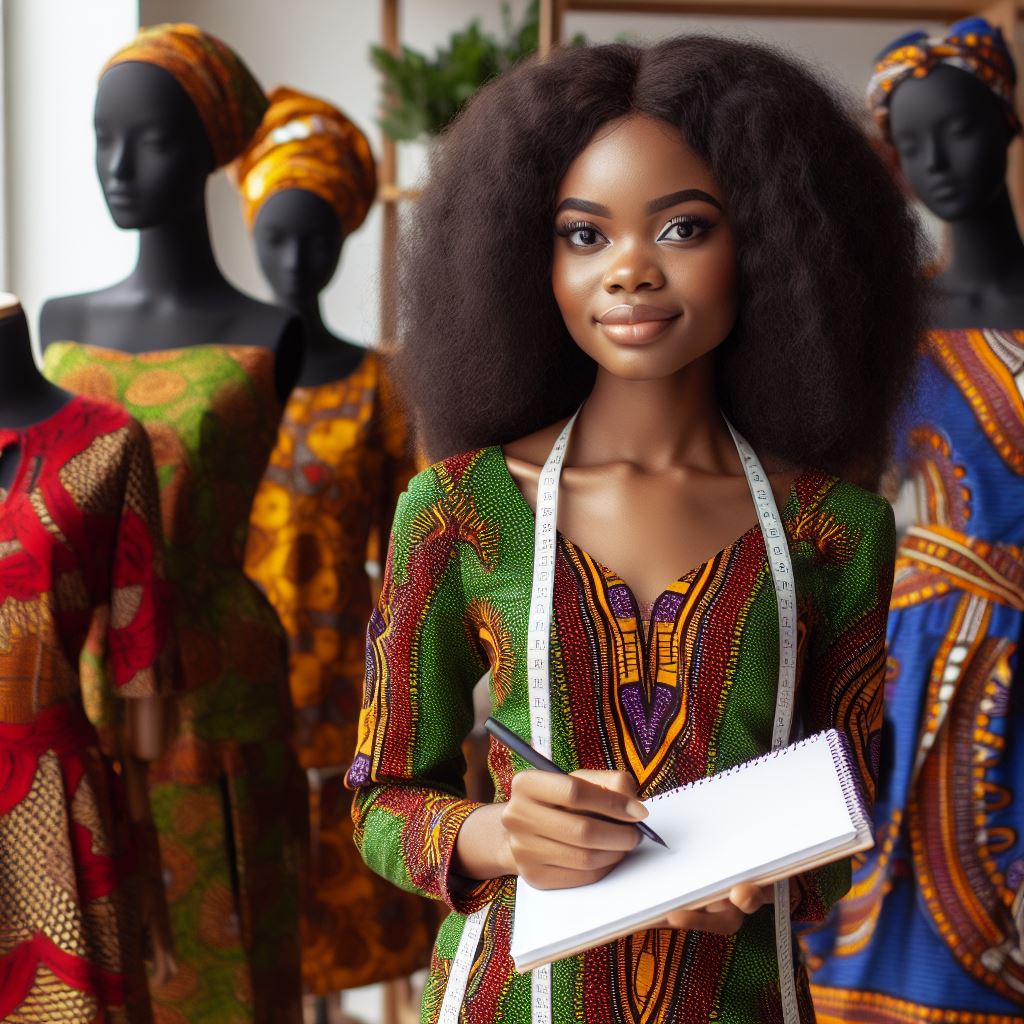Introduction
The Nigerian fashion industry burgeons with creativity and diversity. Fashion designers are its backbone, shaping trends and identities.
Overview of the Nigerian Fashion Industry
Nigeria’s fashion scene thrives with vibrant colors, rich cultural influences, and dynamic designs. It’s a melting pot of tradition and modernity, constantly evolving to meet global standards while maintaining its unique flair.
From traditional attire like the elegant Aso-ebi to contemporary streetwear, Nigerian fashion embraces a spectrum of styles.
Designers draw inspiration from diverse sources, blending traditional fabrics with innovative techniques to create stunning ensembles.
Importance of Fashion Designers in the Industry
Fashion designers serve as visionaries, translating cultural heritage and contemporary influences into wearable art. Their creations not only adorn bodies but also convey stories, traditions, and aspirations.
These designers play a pivotal role in driving economic growth, contributing to job creation and export revenue. They also serve as cultural ambassadors, promoting Nigeria’s rich heritage on the global stage.
In an industry marked by fierce competition, fashion designers face numerous challenges that demand resilience, creativity, and adaptability.
Challenges Facing Nigerian Fashion Designers
- Infrastructure Deficiency: Inadequate infrastructure hampers production, distribution, and access to markets, hindering designers’ ability to scale their businesses.
- Intellectual Property Rights: Copyright infringement is rampant, with many designers facing the theft of their designs, undermining creativity and profitability.
- Access to Finance: Limited access to capital restricts designers’ ability to invest in equipment, materials, and marketing, impeding business growth.
- Skills Gap: Despite abundant talent, a lack of formal training and mentorship programs hinders designers’ ability to refine their craft and compete globally.
- Market Saturation: The market is saturated with counterfeit products, eroding consumer trust and undermining the viability of authentic Nigerian brands.
- High Production Costs: Rising production costs, fueled by inflation and currency fluctuations, squeeze profit margins, making it challenging for designers to operate sustainably.
- Limited Retail Infrastructure: The absence of well-established retail outlets and e-commerce platforms restricts designers’ access to consumers, limiting their reach and sales potential.
- Inconsistent Policies: Fluctuating government policies and regulatory uncertainties create a volatile business environment, deterring investment and innovation.
Despite these challenges, Nigerian fashion designers demonstrate remarkable resilience, leveraging creativity, innovation, and collaboration to overcome obstacles and thrive in a competitive global landscape.
In general, Nigerian fashion designers are instrumental in shaping the industry’s trajectory, blending tradition with innovation to create unique, globally acclaimed designs.
While challenges persist, their ingenuity and determination continue to propel Nigeria’s fashion industry forward, inspiring generations to come.
Lack of infrastructure and resources
Limited Access to Quality Materials and Equipment
Fashion designers in Nigeria often grapple with a scarcity of top-notch materials and tools. This scarcity hampers their ability to create high-quality designs. They are left to make do with subpar substitutes, compromising the integrity of their work.
Poor Transportation and Logistics Hinders Production and Distribution
Transportation woes plague the fashion industry, causing delays and inefficiencies in both production and distribution. Designers struggle to move raw materials and finished products from one point to another.
This logistical nightmare not only hampers timely deliveries but also increases costs, which are ultimately borne by consumers.
Insufficient Funding and Support for Budding Designers
Securing financial backing is a Herculean task for many aspiring fashion designers in Nigeria. Banks and investors are often hesitant to invest in this sector due to perceived risks and lack of understanding.
Consequently, budding talents are left to fend for themselves, struggling to bring their creative visions to life without adequate resources or support.
Forge Strategic Partnerships
In the face of limited resources, fashion designers must proactively seek out strategic partnerships.
Collaborating with suppliers, manufacturers, and distributors can provide access to better materials and streamlined logistics, enhancing overall efficiency and productivity.
Explore Alternative Funding Channels
To overcome the funding challenge, designers should explore alternative financing options. Crowdfunding, grants, and competitions offer avenues for securing capital without relying solely on traditional financial institutions.
Additionally, government initiatives and industry associations may provide grants or mentorship programs to support emerging talents.
Advocate for Infrastructural Development
Designers can collectively advocate for infrastructural improvements within the fashion industry.
Lobbying for better transportation networks, access to technology, and the development of specialized fashion hubs can alleviate logistical bottlenecks and enhance the overall ecosystem for designers.
In short, While the challenges facing Nigerian fashion designers are undeniably daunting, they are not insurmountable.
By adopting a proactive approach, forging strategic partnerships, exploring alternative funding channels, and advocating for infrastructural development, designers can navigate these obstacles and carve out a path to success.
With determination, resilience, and a collaborative spirit, the Nigerian fashion industry can flourish, showcasing the rich tapestry of creativity and talent that defines it.
Read: Impact of Communication Arts on Nigerian Media
Counterfeiting and copyright infringement
One of the significant challenges facing Nigerian fashion designers today is the issue of counterfeiting and copyright infringement.
This problem arises when counterfeiters replicate or imitate original designs without authorization, leading to a loss of revenue and reputation for the designers.
Counterfeiters often mass-produce cheap copies of popular designs, flooding the market with inferior quality products that undermine the credibility of authentic designers.
This rampant copying not only affects the financial viability of designers but also diminishes the value of their creativity and hard work.
Impact of Inadequate Legal Protection
Nigerian fashion designers face another challenge in the form of inadequate legal protection for their original designs.
The existing intellectual property laws in the country do not provide sufficient safeguards for designers against unauthorized reproduction of their work.
Designers are often unable to obtain patents or trademarks for their creations, leaving them vulnerable to exploitation by counterfeiters who take advantage of this legal loophole.
As a result, designers struggle to assert their rights and protect their intellectual property from infringement.
Enforcement of intellectual property rights
Enforcing intellectual property rights is a daunting task for Nigerian fashion designers due to the lack of effective mechanisms for combating counterfeiting and copyright infringement.
Designers face challenges in identifying and pursuing legal action against counterfeiters, especially when operating in a complex and opaque market environment.
The absence of specialized enforcement agencies and legal frameworks further complicates the process of safeguarding designer’s rights.
Without proper support and enforcement mechanisms, designers find it challenging to prevent unauthorized use of their designs and seek redress for infringements.
In essence, the prevalence of counterfeiting and copyright infringement poses a significant threat to the growth and sustainability of the Nigerian fashion industry.
Designers must advocate for stronger intellectual property protection, enhance collaboration with law enforcement agencies, and raise awareness about the detrimental effects of counterfeit products on the industry.
Read: Communication Arts: Job Prospects and Salaries
Limited Market Access: Overcoming Hurdles in Reaching Global Audiences
Navigating the intricate world of fashion design in Nigeria presents an array of challenges, with limited market access emerging as a prominent obstacle.
Lack of Exposure: Struggling to Break Through
Nigerian fashion designers often find themselves grappling with the issue of exposure on the global stage. Despite the abundance of talent within the industry, the lack of visibility hinders their ability to reach wider audiences.
In an era dominated by social media and digital platforms, breaking through the noise requires strategic marketing efforts and savvy networking. However, many designers face barriers in accessing these channels due to limited resources or knowledge gaps.
Limited Opportunities: The Quest for Showcasing and Selling
Another pressing concern is the scarcity of opportunities for showcasing and selling designs.
While local fashion events and exhibitions provide some visibility within the Nigerian market, the platform to exhibit on an international scale remains elusive for many designers.
Securing a spot at renowned fashion weeks or securing partnerships with global retailers often demands significant financial investment and industry connections, resources that are not readily available to all.
High Competition: Navigating the Landscape
Furthermore, Nigerian designers must contend with fierce competition from established international brands. The saturation of the market with well-known labels makes it challenging for emerging talents to carve out their niche and capture consumer attention.
Consumers often gravitate towards familiar names, leaving little room for newcomers to gain traction. This dynamic intensifies the struggle for visibility and market share, as designers vie for attention amidst a sea of competitors.
Strategies for Success: Overcoming Barriers
Despite these formidable challenges, Nigerian fashion designers possess resilience and ingenuity, leveraging innovative strategies to overcome barriers and thrive in the global arena.
Collaborations with influencers and celebrities can amplify brand visibility, while strategic partnerships with local and international retailers offer access to new markets.
Additionally, embracing e-commerce platforms and digital marketing allows designers to bypass traditional gatekeepers and connect directly with consumers worldwide.
Investing in education and skills development equips designers with the tools and knowledge needed to navigate the complexities of the industry effectively.
In fact, While the road to success may be fraught with obstacles, Nigerian fashion designers are poised to make their mark on the global stage.
By harnessing creativity, resilience, and strategic thinking, they can overcome limited market access and position themselves as forces to be reckoned with in the ever-evolving world of fashion.
Read: Digital Media Trends in Communication Arts

Unstable Economic Environment: Navigating the Storm
In Nigeria’s bustling fashion industry, designers face a relentless barrage of challenges, with the economic landscape proving to be one of the most formidable adversaries.
Fluctuating Exchange Rates: Balancing Act
Designers grapple with the unpredictable nature of exchange rates, which directly impact the cost of production.
A sudden rise in the value of foreign currency can send production costs soaring, squeezing profit margins and straining resources. This volatility makes it difficult for designers to forecast expenses accurately and plan budgets effectively.
To mitigate the impact of fluctuating exchange rates, designers often resort to hedging strategies or sourcing materials locally. However, these solutions are not foolproof and may introduce additional complexities and costs into the production process.
Transform Your Career with Expert Guidance
Get personalized mentorship consulting that’s tailored to your unique path. Our expert advice is actionable and exclusive.
Get StartedEconomic Downturns: Weathering the Storm
In times of economic downturns, consumer spending on luxury items takes a hit as disposable incomes shrink and priorities shift.
Nigerian fashion designers find themselves grappling with dwindling demand and fierce competition for a smaller market share.
The ripple effects of economic downturns reverberate throughout the industry, leading to decreased sales, inventory pile-ups, and cash flow challenges.
To survive in such turbulent times, designers must adapt quickly, perhaps by diversifying their product offerings or exploring new market segments.
Impact on Consumer Spending: Balancing Act
Setting competitive pricing strategies becomes an intricate dance in the face of economic instability. Designers must strike a delicate balance between maintaining profitability and ensuring their products remain accessible to consumers.
The challenge lies in offering value without compromising quality or undercutting competitors.
However, the ever-shifting economic landscape complicates this task, forcing designers to constantly reassess and recalibrate their pricing strategies to stay afloat.
Navigating the Maze: Strategies for Success
Despite these formidable challenges, Nigerian fashion designers possess resilience and ingenuity, navigating the maze of economic uncertainties with tenacity and creativity.
Some designers opt for vertical integration, controlling every aspect of the production process to minimize external dependencies and mitigate risks associated with economic fluctuations.
Others focus on building strong brand identities and cultivating loyal customer bases, leveraging social media and digital platforms to connect directly with consumers and bypass traditional retail channels.
Collaborations with local artisans and craftsmen not only support the community but also provide designers with a unique selling point and a story to tell, resonating with consumers who value authenticity and ethical production practices.
In review, while the unstable economic environment presents formidable challenges for Nigerian fashion designers, it also serves as a catalyst for innovation and resilience.
By adopting strategic approaches and embracing flexibility, designers can navigate the stormy seas of economic uncertainty and emerge stronger and more competitive in the ever-evolving fashion landscape.
Read: Famous Nigerian Alumni of Communication Arts Programs
Difficulty in accessing skilled labor
Difficulty in Accessing Skilled Labor
Nigeria’s fashion industry is vibrant and dynamic, but it grapples with numerous challenges. One of the significant hurdles is the difficulty in accessing skilled labor.
This poses a considerable barrier to the growth and sustainability of fashion businesses in the country.
Shortage of Trained and Experienced Artisans
One of the primary issues faced by Nigerian fashion designers is the scarcity of trained and experienced artisans.
While there is no shortage of creative talent in the country, there is a glaring gap in the availability of skilled professionals who can translate these creative visions into tangible products.
This shortage often results in delays in production schedules and compromises the quality of the final output.
Fashion designers frequently find themselves in a constant struggle to locate artisans who possess the necessary expertise in pattern making, cutting, sewing, and finishing.
This scarcity not only hampers the efficiency of their operations but also limits their ability to scale their businesses.
High Costs Associated with Hiring Skilled Workers
Another challenge exacerbating the issue of accessing skilled labor is the high costs associated with hiring such workers.
In Nigeria, skilled artisans command premium wages due to their scarcity, driving up the overall production costs for fashion designers.
This places additional financial strain on already resource-constrained businesses, particularly small-scale enterprises and startups.
Fashion designers often find themselves grappling with the dilemma of balancing quality with affordability.
While they understand the importance of investing in skilled labor to maintain product standards, they are also constrained by budgetary limitations.
Consequently, many designers are forced to compromise on either quality or profitability, further hindering their competitiveness in the market.
Need for Continuous Training and Development Programs
Addressing the shortage of skilled labor in Nigeria’s fashion industry requires a multifaceted approach. One essential aspect is the implementation of continuous training and development programs.
These initiatives aim to bridge the skills gap by equipping aspiring artisans with the necessary technical expertise and craftsmanship.
Fashion designers, in collaboration with industry stakeholders and educational institutions, can play a pivotal role in designing and implementing such programs.
By investing in training initiatives, designers not only contribute to the development of a skilled workforce but also ensure the long-term sustainability of the fashion ecosystem in Nigeria.
In a nutshell, the difficulty in accessing skilled labor poses significant challenges for Nigerian fashion designers.
Addressing this issue requires concerted efforts from various stakeholders, including designers, policymakers, and educational institutions.
By investing in training, promoting skill development, and addressing structural barriers, the Nigerian fashion industry can unlock its full potential and thrive in the global market.
Cultural and Societal Challenges
Pressure to Conform to Traditional Norms and Styles
In Nigeria, fashion designers encounter relentless pressure to adhere to conventional norms and styles. The societal expectation often demands conformity to established cultural clothing traditions.
This expectation can stifle creativity and innovation, pushing designers towards a repetitive cycle of producing familiar designs. For emerging designers, especially those seeking to carve out a unique niche, this pressure can be particularly daunting.
Breaking away from tradition requires courage and a willingness to challenge societal expectations.
However, doing so can lead to a broader appreciation of diversity within Nigerian fashion.
By embracing traditional elements while infusing modern twists, designers can create pieces that honor heritage while appealing to contemporary tastes.
Limited Acceptance of Avant-garde Designs in Mainstream Society
Avant-garde fashion, with its experimental and boundary-pushing nature, often struggles to find acceptance in Nigeria’s mainstream society.
The conservative mindset prevailing in many communities tends to favor safe, familiar styles over bold, unconventional designs.
Consequently, designers pushing the boundaries face an uphill battle in gaining recognition and acceptance for their work.
However, this challenge also presents an opportunity for designers to pioneer change and expand the country’s fashion landscape.
Through strategic marketing and exposure, avant-garde designers can gradually shift societal perceptions and foster a greater appreciation for innovative fashion.
Balancing Creativity with Commercial Viability in a Conservative Market
Finding the delicate balance between creativity and commercial viability is perhaps one of the most significant challenges Nigerian fashion designers face.
In a conservative market where traditional styles reign supreme, designers must navigate the fine line between artistic expression and market demand.
This balancing act requires careful consideration of consumer preferences, trends, and production costs.
While pushing creative boundaries is essential for staying relevant and inspiring change, designers cannot ignore the practicalities of running a profitable business.
Successful designers strike a harmonious balance between creativity and commercial viability, creating designs that capture the imagination while resonating with consumers’ tastes and preferences.
Overcoming Challenges and Driving Change
To overcome these challenges, Nigerian fashion designers must embrace innovation and diversity.
By celebrating Nigeria’s rich cultural heritage while embracing modernity, designers can create fashion that transcends boundaries and captures global attention.
Collaboration and support within the fashion community are also essential for driving change and challenging societal norms.
Through collective efforts, designers can amplify their voices and influence, paving the way for a more inclusive and dynamic fashion industry in Nigeria.
Ultimately, by daring to be different and pushing the boundaries of creativity, Nigerian fashion designers can shape the future of fashion both locally and internationally.
Conclusion
Challenges Facing Nigerian Fashion Designers Today
Nigerian fashion designers face various challenges that hinder their success and growth in the industry. One major obstacle is the lack of access to funding and financial support, which makes it difficult for designers to invest in their businesses and expand their reach.
Another challenge is the presence of counterfeit products and intellectual property theft, which undermines the work of local designers and affects their profitability.
This issue not only affects their revenue but also damages their reputation in the market.
Additionally, Nigerian designers struggle with limited access to quality materials and equipment, which impacts the overall quality of their products and limits their ability to compete on a global scale.
This lack of resources hinders their creativity and innovative potential.
Moreover, Nigerian fashion designers often face stiff competition from international brands and mass-produced clothing, which makes it challenging for them to stand out in the market and attract a loyal customer base.
This competition puts pressure on local designers to lower their prices, affecting their profit margins.
In closing, Nigerian fashion designers are confronted with a myriad of challenges that impede their success and growth in the industry.
It is crucial for stakeholders to provide more support, resources, and funding to help designers overcome these obstacles and thrive.
Celebrating and promoting the creativity of local designers is essential in showcasing the rich cultural heritage and diversity of Nigerian fashion.
By uplifting and empowering these designers, we can contribute to the growth of the fashion industry and elevate the status of Nigerian fashion on a global scale.




